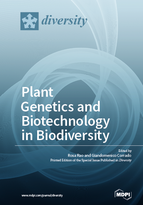Plant Genetics and Biotechnology in Biodiversity
A special issue of Diversity (ISSN 1424-2818). This special issue belongs to the section "Plant Diversity".
Deadline for manuscript submissions: closed (30 September 2017) | Viewed by 83421
Special Issue Editors
Interests: plant biotechnology; genetic and genomic characterization of plant germplasm; molecular markers; ‘omics’ in plant defense studies
Interests: crop biodiversity; landraces; genetic modification; DNA polymorphism; genetic fingerprinting
Special Issues, Collections and Topics in MDPI journals
Special Issue Information
Dear Colleagues,
Plant biodiversity is central to the implementation of sustainable production systems, ensuring global food security, and increasing crop resistance and resiliance to climate change and invasive and native biotic stresses. Plant genetic resources (PGR) have been collected and exchanged for centuries, but the rapid development of novel tools for genetic analysis is changing the way we can uncover diversity and exploit its value in agriculture. The integration of novel analytical tools is currently crucial for translating research into a much-needed, more efficient management and use of PGR.
The forthcoming Special Issue aims to provide an overview of recent topics on plant genetics and biotechnology in biodiversity, with enphasis on agricultural genetic diversity. Papers will present current trends on genetic resources description, conservation, management and research, and will highlight how new approaches and methodogies can boost both our understanding and exploitation of PGR.
This Special Issue is launched to honor the memory of Prof. Gian Tommaso Scarascia Mugnozza, and in recognition of his many contributions to plant breeding and genetic resources.
Prof. Rosa Rao
Dr. Giandomenico Corrado
Guest Editors
Manuscript Submission Information
Manuscripts should be submitted online at www.mdpi.com by registering and logging in to this website. Once you are registered, click here to go to the submission form. Manuscripts can be submitted until the deadline. All submissions that pass pre-check are peer-reviewed. Accepted papers will be published continuously in the journal (as soon as accepted) and will be listed together on the special issue website. Research articles, review articles as well as short communications are invited. For planned papers, a title and short abstract (about 100 words) can be sent to the Editorial Office for announcement on this website.
Submitted manuscripts should not have been published previously, nor be under consideration for publication elsewhere (except conference proceedings papers). All manuscripts are thoroughly refereed through a single-blind peer-review process. A guide for authors and other relevant information for submission of manuscripts is available on the Instructions for Authors page. Diversity is an international peer-reviewed open access monthly journal published by MDPI.
Please visit the Instructions for Authors page before submitting a manuscript. The Article Processing Charge (APC) for publication in this open access journal is 2600 CHF (Swiss Francs). Submitted papers should be well formatted and use good English. Authors may use MDPI's English editing service prior to publication or during author revisions.
Keywords
- plant conservation genetics
- plant biodiversity
- plant biotechnology in conservation and bioprospecting
- DNA markers
- plant genomics
- biodiversity in bio-based economy






